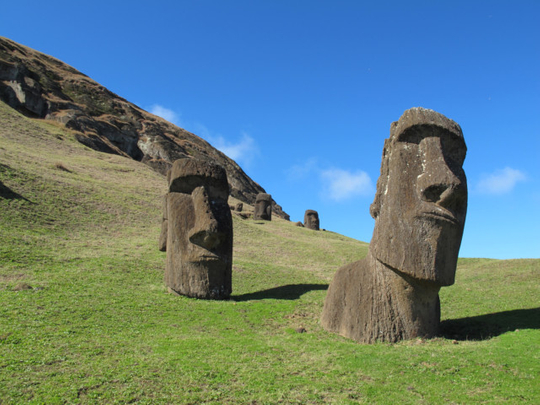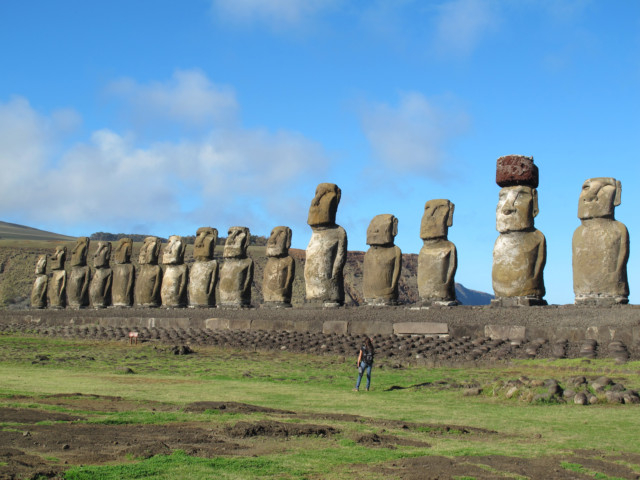
From its famed giant stone statues to finding a good, affordable hotel, Easter Island is full of mysteries.
There are ancient questions — how were the statues transported, and why the island lost its trees. And there are modern puzzles — what $1,600 (Dh5,872) a night will get you in a hotel and why roads aren’t better marked for visitors touring the island.
Perhaps it’s fitting that riddles still exist on the most remote inhabited island on earth: a Chilean territory in the South Pacific, 3,700 kilometres to the west of the South American continent.
Yet I hoped for answers. After flying nearly 20 hours from New York, and having one of our group shaken down for a bribe by a customs’ agent, I wanted to not only see the sites, but understand them.
My in-flight reading was a recent issue of National Geographic magazine, which outlined six different theories on how a people with no wheel and no draft animals were able to move massive statues weighing up to 90 metric tonnes as much as 18 kilometres across the island. I arrived better informed, but no wiser.
We were greeted in the Polynesian tradition with flower leis, then given a brief tour of the town of Hanga Roa, home to most of the island’s 5,500 residents.
With more than 50,000 visitors a year, the island is home to an assortment of restaurants, car rental agencies, markets, souvenir stores, watersport shops and small hotels, and since everything is imported to the island, prices are high.
Our hotel, like most, was tucked in tight between homes and businesses. Ranked on TripAdvisor as one of the best, for $150 a double, it was clean, but the neighbours were loud at night, and the resident roosters were loud at dawn. Although the roosters belonged to the hotel, we wondered if they were bachelors: Nary an egg was seen in the monotonous breakfast.
It had been a challenge to plan the trip. Little independent information is available online, and Easter Island, or Rapa Nui as the locals call it, is but a few pages in most guidebooks. Most hotels appeared Spartan, while the luxurious and all-inclusive Explora is $1,600 a night. A new option, the waterfront Hangaroa Eco Village & Spa, at $550 a night, looked lovely and was rooster-free.
Aside from the hotel, we arranged one other thing in advance: a daylong outing with James Grant-Peterkin, author of the book, A Companion To Easter Island.
His tour took us around the 163-square-kilometre island, introducing us to the moai statues. Although they are often referred to as heads, they are in fact whole-body carvings made by descendants of the first Polynesian settlers hundreds of years ago. Just what they represent and why they were toppled in the century after the first European explorers arrived in 1721 is another unknown.
Fewer than 50 of the statues have been re-erected by archeologists, and the most impressive of these is a site where 15 colossal moai stand on a ceremonial platform more than about 213 meters long. With their backs to the pounding surf, this is a favourite spot to watch the sunrise.
Just down the road is the National Park of Rano Raraku, the quarry where the moai were carved. A path winds among the 400 statues, completed to varying degrees. Whatever their reason, there is no doubt that workers stopped ahead of schedule, leaving a stone graveyard to what was once a sophisticated civilisation.
Most of the moai are buried up to the neck, giving the impression that they are nothing more than heads. One, lying on its back, measures about 21 metres in length. Another has a petroglyph of a European sailing ship scratched onto its belly. One depicts the moai kneeling, the only one known to have legs. Sadly, this unique sculpture is being worn away by the elements, something people here seem resigned to accept.
On subsequent days, we toured by ourselves, in a rental car or on four-wheel ATVs. As we wandered around getting lost on the bumpy roads, we learned that the island is much more than moai.
We visited the site of the ancient birdman competitions, where men would scramble down a 300-metre cliff, then swim 1.6 kilometres through crashing waves to a rookery where they would camp, waiting to claim a tern egg for their chief.
We saw volcanic craters, explored a 6.4-kilometre-long lava tube, and swam off a sandy beach in the shadow of more moai. The beach was one of the few places with trees, and these palms were imported from Tahiti.
Just who is responsible for the deforestation of this once tropical island is another matter of debate. Some believe the first settlers cleared too much for farming and firewood, and inadvertently brought about the end of their civilization. Others blame the moai, believing the trees were cut to make sleds to move them. Still others think that Polynesian rats brought in the settlers’ canoes ate the palm nuts and prevented propagation.
Yet another small wonder can be found at the island’s tiny, and somewhat disorganized, museum. Here, one can examine copies of the wooden Rongo Rongo tablets, which are covered in an unknown script. Only 26 of these remain in existence, all overseas, and all undeciphered.
My trip was almost over and still I had found no answers. So I returned to the Rano Raraku quarry just before the park closed for one last look. There, virtually alone among the moai, I said goodbye to a fascinating place and its lost culture. I’d come to accept that the stone lips would never to give up their secrets.
WHAT’S IN A NAME?
The original name of the island is lost. It is called Easter Island because the first Dutch explorer spotted it on Easter in 1721. The locals, however, call the island and their language Rapa Nui and refer to themselves as Rapanui. This name likely originated in the 19th century, and literally translates to “Big Rapa”, which may refer to the island of Rapa in French Polynesia.
IF YOU GO
EASTER ISLAND: http://www.easterislandspirit.com and http://www.easterislandtourism.com. A Rapa Nui National Park pass is $50 at the airport for non-Chileans, $60 elsewhere.
GETTING THERE: Direct flights on LAN Airlines from Santiago, Chile, Lima, Peru, and Tahiti.



